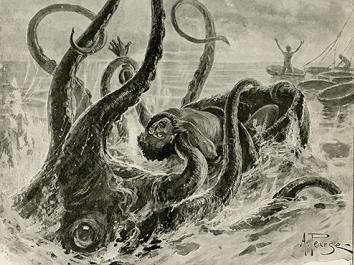Louise Alfred Pearse, The Great Octopus, 1898.
The Wide World magazine, an English adventure monthly, (1898-1965), working on the motto ‘fact is stranger than fiction’ began to serialize the adventures of a certain Louis de Rougemont as told by himself. The stories he depicted were so strange, his writing so visual in character and the controversy behind the man so compelling that they quickly garnered a following, continuing to inspire artistic interpretations and responses to de Rougemont’s adventures and the man himself for more than a century.
These fantastical stories were purported to have taken place in the north west of Australia over a 30 year period where de Rougemont, who passed himself off as a French nobleman, had lived. His survival of cannibal tribes, heroic battles, wrestling of gigantic sea monsters and confronting flying wombats captured the imagination of an English public eager for the strange and exotic. Behind these stories however lay another story, that of the man who fabricated this famous hoax; de Rougemont was a fabulist of epic proportions and the British public initially, his willing conspirators. As Henry Lawson, the great Australian writer and poet wrote at the time ‘…according to de Rougemont Australia [is] a wild romantic and picturesque region: a region of Sinbad-ish whales and crocodiles, and flying wild pigs that burrow underground during the daytime, and rise in clouds against the stars of the tropical night. Australia [is] a land of black warriors and dusky brides.’ But even when Louis de Rougemont was exposed for being the fraud that he was, The Wide World Magazine exploited the situation by publishing a ‘Christmas double issue’ to meet the public appetite and increase sales.
Presently showing in the Gordon Victor King Gallery located on the ground floor of The Art Gallery of Ballarat, this over-sized character is explored in the exhibition Australia’s Robinson Crusoe: the fabulous tale of Louis de Rougemont, curated by Peter Freund.
‘It really is Australian’s own Robinson Crusoe story, something I think deserves more awareness,’ Freund says.
Succinct didactic panels placed at intervals around the room sketch the tale of Henri-Louis Grin, the man behind the name, he was born in 1847, the son of a Swiss merchant. As a young adult Grin travelled extensively as footman to the actress Fanny Kemble, learning English and later travelling to Australia as a butler to the new governor of Western Australia, Sir William Robinson. During his time in Australia he lived an adventurous life finally ending up in Sydney, marrying and fathering seven children before deserting his wife and travelling back to England; it is at this stage ‘the story’ of Louis de Rougemont begins.
Schematic panels provide an overview of de Rougemont’s adventures while original photolithograph prints from The Wide World Magazine by the noted illustrator Alfred Pearse give the viewer a romanticized version of the tales. “I then shot half-a-dozen arrows into the enemy’s ranks” (1898) depicts in wonderful detail a wild looking de Rougemont in battle with ‘the natives’. Juxtaposing Pearse’s interpretation of the de Rougemont tales are the clever satirical works of Phil May who produced cartoons for the Daily Chronicle in London but had lived for a time in Australia. It was the Chronicle’s editor, Henry Massingham who finally exposed de Rougemont as a fraud and May’s characteristic black and white ink images such as A nation turns out to meet me-Fiction (1898) shows our hero astride a crocodile being hailed on all sides by the indigenous inhabitants. Here, however, he is depicted as a figure of ridicule.
Some more contemporary responses to de Rougemont’s adventures by husband and wife team Mark Greenwood, (author) and Frané Lessac, (illustrator) are also on display. The picture book The Greatest Liar on Earth, (2013), is a retelling of the tale with Lessac’s colourful gouche illustrations capturing the explorer battling a giant squid or riding the back of an enormous turtle. Other contemporary interpretations can be seen in the posters of Shipwrecked that line the back wall of the gallery promoting the production by Pulitzer prize winning play write Donald Margulies, premiering in 2007. Ron Howard’s novel The Fabulist, (2006) a story of de Rougemont’s exploits and unmasking is on display in the space’s central cabinet along with other related literature.
What better setting for such an exhibition than Australia’s oldest regional gallery set in the heart of ‘gold field territory’ where once many a trickster, like Louis de Rougemont, may have contrived a living in the young and often lawless colony of Victoria in the 1850s.
An intriguing and well curated show that brings together a range of perspectives and creative responses to this fascinating tale. Well worth a visit.
Rating: 3.5 stars out of 5
Australia’s Robinson Crusoe: the fabulous tale of Louis de Rougemont
The Art Gallery of Ballarat
Saturday 13 June – Sunday 9 August
10 – 5pm daily





